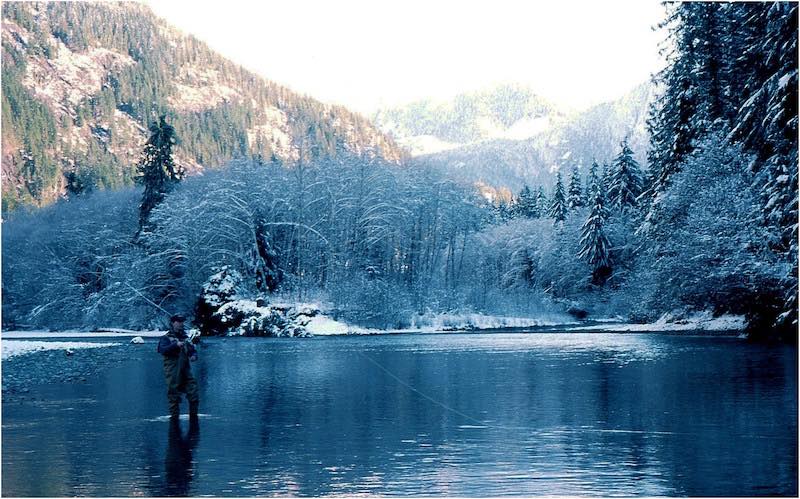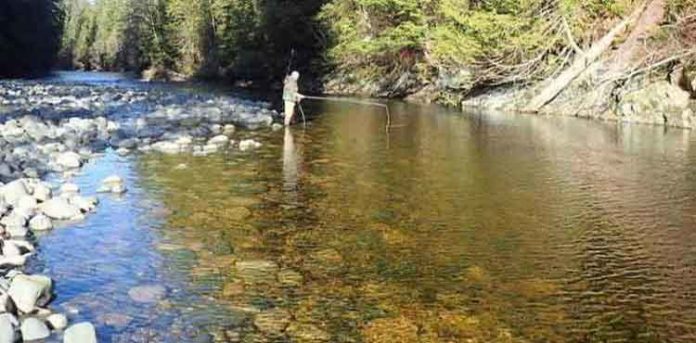by Rory Glennie
In my opinion, winter-run steelhead are simply the toughest fly-fishing challenge on coastal streams—period. If there is any form of fly fishing that requires anglers to pay their dues by putting in countless long hours and many days before being graced with a hook-up from their quarry, winter-run steelhead fly-fishing is it.
Someplace to Start
Several easily accessed island rivers suffer from depleted runs, and many are subsequently closed to wintertime angling. We hope runs will rebuild and we can soon again pursue fly fishing on them. Studying the current angling regulations synopsis may offer clues to which are the streams most likely to host fishable numbers of winter-runs.
Both logging-road and highway bridges cross many streams. Scoping out the flows from them can help you plan your trip, and you go either further upstream or downstream depending on the clarity and quantity of the water. River flow charts found at www.wateroffice.ec.gc.ca can be very helpful in this regard.
The Learning Curve
Starting out on your own by stumbling about blindly on a winter steelhead stream is not recommended. Linking up with an experienced steelheader or competent angling guide will help kickstart the learning process. Getting a good grounding in the basics of winter steelheading and an understanding of specific run timing will undoubtedly save much useless flogging. Many of the same water types that hold summer steelhead will hold winters. The main practical difference is that winter runs are notorious for hanging tough near the bottom. This requires the fly be drifted almost into their face to elicit a strike. With the heavy flows of winter, one often wonders how a steelhead can hold so easily in such strong currents. The answer, in a word, is hydrodynamics.
Gearing Up to Get Down
Often, heavyweight sink-tip lines coupled to slinky, motile flies swung and drifted with the assistance of multiple line mends are in order. One needs to steer the fly into the fish-taking zone. Having the fly hung and hovered in front of a fish offers the best chance for a take.  Then, too, a floating line with a long leader may be employed to good effect in areas where the fly can be effectively presented with that type of rigging. Floating lines with weighted flies, either bright attractor patterns or buggy nymph-like imitations, can be used with confidence. This “upstream nymphing” method, as it is called, works well for picking the pockets alongside and within more substantial flows. Both the sunk line and floating line technique are best tackled through employing the benefits of using a long two-handed “spey” rod, or in the latest fashion, a “switch” rod. The key here is the ability of the long rod to effectively steer the fly into the fish taking zone.
Then, too, a floating line with a long leader may be employed to good effect in areas where the fly can be effectively presented with that type of rigging. Floating lines with weighted flies, either bright attractor patterns or buggy nymph-like imitations, can be used with confidence. This “upstream nymphing” method, as it is called, works well for picking the pockets alongside and within more substantial flows. Both the sunk line and floating line technique are best tackled through employing the benefits of using a long two-handed “spey” rod, or in the latest fashion, a “switch” rod. The key here is the ability of the long rod to effectively steer the fly into the fish taking zone.
Water Quality and Quantity is Important
Steelhead have to see the fly in order for them to grab it. Muddy water is a no-go, but water clearing up after a muddy period can be ideal. Next to water clarity, the biggest single factor in whether winter steelhead can be expected to move very far to take the fly is water temperature. Generally, warmer springtime flows mean more active fish. Using a submersible thermometer to gauge the temperature can help determine the best technique. The common benchmark water temperature of 42º F, or about 5.5º C, is when steelhead seem more willing to move a bit to intercept or chase the fly. Often, rivers with a large lake in the headwaters maintain a more moderate temperature throughout the winter. Such streams may offer a better chance of finding willing biters even during the coldest periods.
Getting Into Position
To be effective, one cannot just chuck out the fly and hope for it to be covering fish. Editing the river flow—that is, breaking it down into manageable portions as to where steelhead are most likely to be holding, then getting into position to best present to that fish—is paramount to success. Remember hydrodynamics? Steelhead like to hold in the soft water cushion in front of mid-stream boulders and are built to efficiently do just that. They also like to hold in the broad upwelling tail-outs of large pools, again for the same reason: comfort. Into these hot spots is where your fly must be maneuvered.
The Extended Learning Curve
Much has been written on this subject, and it is required reading if one wants to aspire to proficiency in winter fly fishing. Books like Steelhead Fly Fishing & Flies by Trey Combs, Dry Line Steelhead by Bill McMillan, and of course Roderick Haig-Brown’s books are some good places to start. Studying the works of these masters is a worthwhile pastime in itself. Of course, plenty of websites offer up valuable information, but there are no shortcuts to the advantages of actual on-stream experience.






